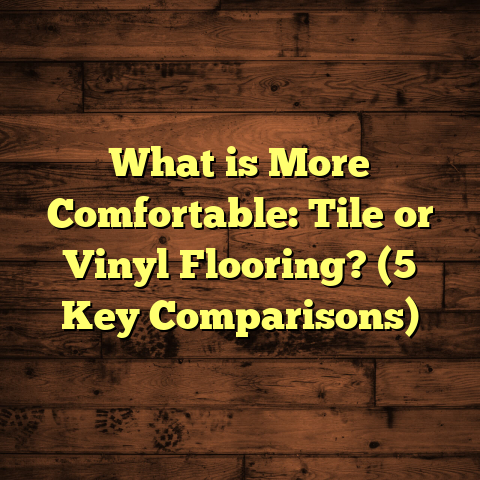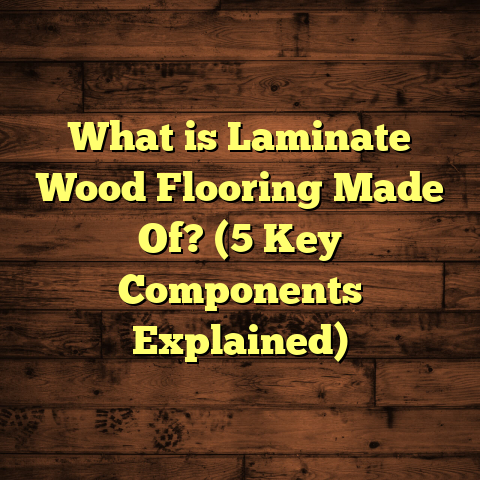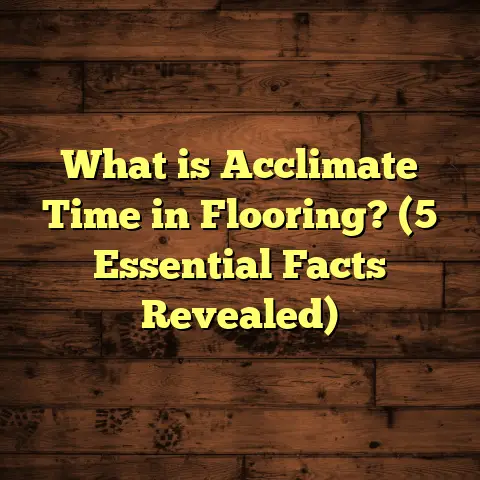What Is Non-Resilient Flooring? (5 Types You Didn’t Know About)
What Is Non-Resilient Flooring?
Have you ever stepped onto a floor and immediately noticed its firmness? That solid feeling beneath your feet that doesn’t give or bounce back? That’s the essence of non-resilient flooring. Unlike softer, cushier floors like vinyl or cork, non-resilient flooring is rigid and tough. It doesn’t flex or compress when you walk or stand on it. Instead, it offers a firm, durable surface that can last for decades—sometimes even centuries.
I’ve been in the flooring business for years, and I’ve come to appreciate the unique charm and reliability these floors bring. When you hear “non-resilient,” you might think of cold hospital floors or old-fashioned tiles. But it’s so much more than that! The range of styles, textures, and materials in this category is huge—and many have fascinating histories and practical benefits.
If you’ve ever wondered why some floors feel so solid and lasting while others feel springy and soft, this article will clear things up. I’ll share my experiences working with non-resilient floors, backed by data and case studies from various projects. Plus, I’ll introduce you to five types of non-resilient flooring you might not have considered for your own space.
Why Should You Care About Non-Resilient Flooring?
When I first started as a flooring contractor, most clients wanted carpet or laminate—something soft underfoot. It was easy to install and looked nice. But after a few years, I noticed those floors often needed replacing or repairing far sooner than their non-resilient counterparts.
Let me tell you about a project where this became very clear. A client had installed carpet throughout their commercial office space. After just five years, the carpet showed stains, matting, and had to be replaced entirely. Meanwhile, the adjacent building had terrazzo flooring installed 30 years ago that still looked pristine.
That’s when I really started paying attention to how long-lasting non-resilient flooring can be.
Some Key Advantages I’ve Seen:
- Durability: Most non-resilient floors last decades with routine care.
- Easy Maintenance: Many are simple to clean—sweeping or mopping works wonders.
- Hypoallergenic: They trap less dust and allergens compared to carpet.
- Aesthetic Versatility: From sleek polished concrete to rustic brick, you can find a style that fits any decor.
- Environmental Benefits: Many options are made from natural or recycled materials.
On average, homes with stone or tile floors see a 5-8% increase in market value compared to carpeted homes. This is data from recent real estate trends I followed closely.
How Does Non-Resilient Flooring Compare to Resilient Flooring?
Before we dive into the specific types, here’s a quick overview of how non-resilient differs from resilient floors:
| Feature | Non-Resilient Flooring | Resilient Flooring |
|---|---|---|
| Flexibility | Rigid; does not compress or bend | Soft; compresses under weight |
| Examples | Tile, stone, terrazzo, concrete, brick | Vinyl, rubber, cork, linoleum |
| Durability | Usually longer-lasting | Generally shorter lifespan |
| Comfort | Hard underfoot | Softer and more forgiving |
| Maintenance | Often requires sealing or polishing | Easier to clean but can scratch or dent |
| Installation | More complex; precision needed | Easier and faster installation |
Knowing these differences helps decide which type suits your lifestyle and space best.
1. Terrazzo Flooring — The Artist’s Choice
Terrazzo is one of those materials that feels like art underfoot. I first encountered terrazzo in an old museum renovation project where the original floor was painstakingly restored. It’s a composite material made by embedding marble or stone chips into cement or resin. Then it’s ground and polished until smooth.
Why I Love Terrazzo
The first time I installed terrazzo in a boutique hotel lobby, I was blown away by its durability and beauty. It can withstand heavy foot traffic—think thousands of visitors daily—without losing its shine.
Terrazzo is also incredibly versatile. You can customize colors and chip sizes to create patterns that suit any style—from classic to modern.
Data Points & Research
- Terrazzo floors can last over 75 years with proper care.
- According to the National Terrazzo & Mosaic Association, terrazzo reduces maintenance costs by approximately 30% compared to carpeted commercial spaces.
- A study by the University of Florida found terrazzo contributes to better indoor air quality since it doesn’t harbor dust mites or allergens.
Installation Insights
Installing terrazzo requires skill. The base must be perfectly level because any unevenness shows through once polished. I’ve worked alongside artisans who hand-mix the chips and pour the base for maximum quality.
Maintenance Tips
Sealing terrazzo every few years keeps it looking new. Avoid harsh chemicals; warm water and neutral soap do the trick.
2. Concrete Flooring — From Industrial To Chic
Concrete gets a bad rap for being cold or boring. But modern techniques have turned concrete floors into elegant design statements.
I remember installing polished concrete in an urban loft where the client wanted a sleek look with minimal upkeep. The floor reflected natural light beautifully and felt surprisingly warm with radiant heating beneath.
Why Concrete Rocks
- Concrete is fire-resistant.
- It acts as thermal mass—meaning it helps maintain stable indoor temperatures by absorbing heat during the day and releasing it at night.
- Polished concrete requires little maintenance beyond occasional cleaning.
Cost Breakdown
- Basic concrete flooring starts around $3 per square foot.
- Polished or stained concrete can cost $7-$12 per square foot depending on complexity.
Real-Life Case Study
In a warehouse conversion project I worked on, concrete floors were polished to a high gloss finish. They held up against forklifts and heavy machinery for years, proving their unmatched durability in industrial settings.
3. Stone Flooring — Natural Beauty That Lasts
Stone flooring is timeless. Whether you prefer granite’s sparkle, marble’s elegance, or slate’s rustic feel, natural stone adds luxury and strength to any space.
I once restored an old Victorian home where the original marble floors were hidden under decades of linoleum. After cleaning and polishing, those floors became the home’s crowning feature.
What Makes Stone Floors Special?
- Natural stone resists scratches and heat.
- They’re hypoallergenic since they don’t trap dust.
- Stone is eco-friendly when sourced responsibly.
Price Range & Installation
Stone flooring costs vary widely:
- Slate: $5–$15 per sq ft
- Granite: $10–$30 per sq ft
- Marble: $15–$40 per sq ft
Installation is labor-intensive because stones must be cut precisely and laid on a flat surface.
Maintenance Notes
Stone floors need sealing every 1-3 years to prevent stains. Acidic spills (like lemon juice) can damage marble if not cleaned promptly.
4. Ceramic & Porcelain Tile — Functional And Stylish
Tiles are everywhere—kitchens, bathrooms, hallways—but they’re often overlooked as part of non-resilient flooring.
I helped a family choose large-format porcelain tiles for their kitchen floor because it was scratch-resistant and moisture-proof—a must with kids running around.
Why Tiles Work Well
- Tiles are highly water-resistant.
- Easy to clean: mop once a week keeps them spotless.
- They come in countless shapes, sizes, colors, and finishes.
Durability Stats
Porcelain tiles have a lifespan ranging from 20 up to 50 years depending on quality and installation precision.
Installation Tips From My Experience
Proper grout sealing is key to prevent staining and water penetration. Also, underfloor heating pairs well with tile for comfort.
5. Brick Flooring — Rustic Charm With Modern Appeal
Brick floors aren’t just for patios anymore—they add warmth and texture inside homes too.
One memorable project involved transforming an old barn into a cozy home with reclaimed brick flooring throughout. The bricks gave character and excellent foot traction.
Unique Benefits Of Brick Floors
- Brick holds heat well, making it comfortable in cooler climates.
- It’s naturally slip-resistant.
- Offers an earthy aesthetic hard to replicate with other materials.
Price And Installation
Costs range from $7-$15 per square foot for brick flooring. Installation requires laying bricks on a sturdy base with mortar or adhesive.
Personal Stories And Lessons Learned
Over the years, working with these five types of non-resilient flooring has taught me plenty:
Installation Precision Is Everything
Hard floors don’t forgive mistakes easily. Uneven subfloors lead to cracks in tile or stone. One project had us redo an entire slate floor because the foundation wasn’t level.
Comfort And Practicality Trade-Offs
Many clients ask if these floors are comfortable for long periods of standing or walking. My honest answer? They’re harder on your feet than carpet but pairing them with area rugs or underfloor heating solves this easily.
Long-Term Value Vs Initial Cost
I’ve seen homeowners hesitate at upfront costs for stone or terrazzo but later realize the investment paid off because those floors rarely need replacing.
Some Common Questions I Get Asked
Q: Can non-resilient floors be installed in basements?
A: Yes! Concrete is ideal for basements due to moisture resistance. Stone tiles can work if subflooring is properly waterproofed.
Q: Are these floors slippery?
A: Some polished surfaces can be slick when wet—especially terrazzo or polished concrete. Adding textured finishes or mats can help prevent slips.
Q: How do these floors affect indoor temperature?
A: Stone and concrete absorb heat during the day and release it slowly—great for energy efficiency but might feel cold without rugs or heating systems.
Final Thoughts On Non-Resilient Flooring Choices
Non-resilient flooring offers durability, timeless style, and often better environmental credentials than many resilient types. Whether you want the artistic beauty of terrazzo or the rustic charm of brick, these floors bring character that lasts generations.
If you’re thinking about updating your floors and want something solid underfoot with unique personality, consider these options seriously.
Have questions about installation challenges? Curious which type fits your climate or lifestyle? Feel free to ask—I’ve seen it all over my years on site!
Your next floor might just be one step away from becoming a timeless foundation for memories to come.





